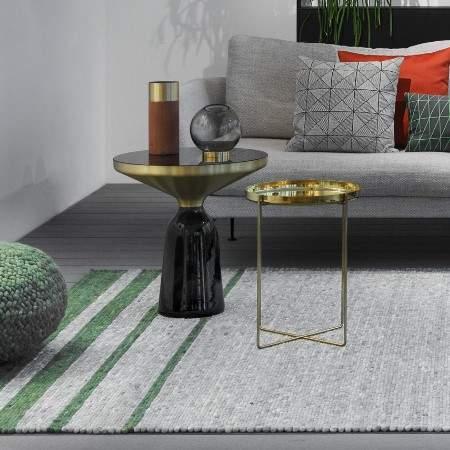Local Storage seems to be disabled in your browser.
For the best experience on our site, be sure to turn on Local Storage in your browser.
Living Room Rugs FAQ
What size rug for the living room?
When it comes living room area rug, the main concern is whether the rug should sit in front of the sofa or go under it. You can opt for either as long as the rug covers the length of your couch. In smaller living rooms, you can do with a rug that sits in front of your sofa probably 6” to 18” so that there is a border around that accentuates your flooring.
In larger rooms, space tends to be better anchored if the rug goes under the couch and comes out on its sides. This works perfectly if you have L-shaped sofas since the rug grounds it well. In such a case, you might want to opt for an 8x10 area rug.
In larger sized rooms, opt for a larger rug and ensure that all the furniture sits on it making sure that there is rug extending behind such that anyone can comfortably walk behind the furniture pieces. If you are going for this option, you are better off getting either a 10x14 rug or a 12x18 rug.
How to place a rug in a living room?
It can be tricky placing a rug in the living room than other rooms in the house. Smaller rugs tend to appear cluttered while large ones make the room appear more spacious and streamlined. Keeping in mind that the main goal is to find a rug that shows off your style and makes the room appear as flawless as possible, then the shape and the size of the rug should matter. There are certain rules that you need to follow when placing a rug in the living room.
The rule of thumb is to have at least 18 inches of uncovered flooring around the border of the rug. However, you need to consider the location and the size of the room. Before you purchase a rug, map out the room to scale considering the furniture size, doorways, and sun exposure. In such a case, you can either place the rug with the sofa’s front legs on the rug and the back legs off, some front legs on, all legs on, or no legs on at all.
How to choose a rug for the living room?
- Size: The first thing to consider when you are choosing an area rug for the living room is the size. One of the mistakes that a majority of people make is getting area rugs that are too small. The standard rugs sizes for the living room are 6 x 9 feet, 8 x 10 feet, and 9 x 12 feet rugs. Such sizes are available in all stores but if they can’t fit your space, you can always have one custom made for you.
- Pattern and color: When you are choosing a rug for your living room, you need to think about the pattern and the color. A patterned rug can add both interest and color to a living room that has neutral colors. A patterned rug also does a better job of concealing spills and dirt than solid ones. If you want your living room to look colorful, then a colorful area rug will work for you.
- Texture: Since the living room sees a lot of foot traffic you need to think about how you want the area rug to feel. Wool rugs for instance add comfort and not to mention are soft underfoot while natural materials like jute and sisal are a little bit rough. Silk on the other hand is beautiful but expensive and it's hard to clean.
- Multiple rugs: If you want to add a little bit more interest and define the space more, then you might give multiple rugs a chance. To achieve this, layer the rugs on top of each other. This option tends to add a little more pattern and color and it’s a great trick for when you want seasonal decorating.
Do you have to have a rug in the living room?
- Just like you would have area rugs in the bathroom, adding an area rug in your living room serves so many functions that you can’t afford to overlook.
- Noise reduction: An area rug tends to significantly decrease noise after all carpet is way quieter to walk on than bare floors and it also absorbs sounds in the air. This works best if you live in an apartment building and you don’t want to disturb your downstairs neighbors especially if you have kids.
- Comfort: A carpeted floor will always be softer than bare hard floors like tile and hardwood. An area rug is softer to walk on as well as stand on which is why you need to consider getting one for your living room.
- Warmth: If you have a hard floor, they can be cold to walk on especially during winter months. An area rug, adds some warmth especially if it comes with a rug pad.
- Grounding aspect: An area rug helps the space to feel more grounded for some reason. For one if an area rug is placed well, it can help anchor your furniture which creates a cozy and intimate space.
How to choose the right color rug for the living room?
One of the most important aspects that you need to consider when you go rug shopping is the color of the rug. This is because the color adds to your style and it should match your décor. First, have an inventory of the color scheme in your living room. You want to tie the room together by selecting a rug color that complements two or three of the major colors in the room. If the primary color in the room is solid and this could be your sofa, then go for a patterned rug.
You also need to ensure that you match the secondary color in a patterned area rug to the color of your sofa. After that, match the third color on the rug to your drapes, pillows, walls, and other accents in the living room. Additionally, if the primary furniture has an upholstered pattern or another elaborate design, a rug with a solid color will work well. The only thing you need to ensure is that the solid color of the rug complements the color of your sofa and matches the accents in the room such as a vase or artwork.
How to determine the size of the area rug for the living room?
Ideally, how you have placed your furniture is what determines the size of the area rug that you will get. You want to have the rug at either the center of the seating area like under the coffee table or the center of the room. To determine the rug size, you need to consider the area size that you intend to cover. With that in mind, there are standard area rug sizes for the living room area.
5 x 8 & 6 x 9 area rugs: With such a rug, there will only be enough room to cover the area around and beneath the coffee table. As such, the area around the sofa will remain uncovered.
8 x 10 rugs: Such a rug will cover that area around the sofa and under the coffee table comfortably.
9 x 12 rugs cover most of the floor in the living room which creates a more consistent look, especially for large living rooms. Regardless of the size of the rug however, your seating should be uniform with either the front legs on the rug, all legs on, or no legs on the rug at all.
Where to position rug in the living room?
When it comes to the positioning of an area rug in the living room, the last thing you want is a rug that will go right to your wall like you are carpeting. Rather there should be a little bit of leeway between the wall and the rug. Rather than a platform, you should think of an area rug as an anchor for the living room. Similarly, you don’t want a rug that is too tiny that it's lost in the vast sea of the floor. If you do decide to go with a small rug, make sure that it is proportionate to your sofa such that it runs beyond the seating and couch area.
The other thing you need to pay attention to when it comes to positioning a rug in the living room is to mimic the shape of your room. Living rooms tend to be square or rectangular shaped especially in a formal seating arrangement. While it's more tempting to try and mimic the shape of your coffee table and opt for a smaller rug, this throws everything off balance especially with a round rug.
With this in mind, there are several places that you can position the rug in the living room. They include at the center with the front legs of the sofa on the rug and the back legs off, all legs on the rug or no legs on the rug at all. You could also opt to leave 18 inches of floor around the rug or just a few inches of the floor around it.
How to choose an area rug color for the living room?
Picking the color of the area rug for your living room is difficult because there is furniture in the living room that you need to think about and the fact that the living room experiences a lot of leg traffic. When choosing a rug color, there are a few options that you may want to consider. Deep rich colors for instance create more intimate spaces while light colors make smaller spaces appear larger. You should also consider shades as well as contrasts. Muted and soft shades blend well to warm colors of walls such a yellow, orange, and red. With this in mind, avoid going for rugs that are of the same color as your walls since they tend to be too loud and one wouldn’t know what to concentrate on.
Cool colors are another option since they create a calmer atmosphere while darker colors are ideal if you have stains on your hardwood floor for instance. With formal colors, one thing that you need to remember is that the rug color can either make or break your room in which case the color and the pattern of the rug tend to anchor any elements in the room. Muted color tones create a serene and tranquil setting in the living room. You might also want to opt for rug colors that complement the existing décor.
How to lay a rug in a living room?
Before you place an area rug in the living room, the most important thing that you need to consider is the size of the rug. Ideally, the rug needs to pull the furniture in the living room together. Putting a small rug at the center of the room will only draw attention to the rug and not the furniture. Ideally, it's recommended that you purchase seating before you buy a rug since it will be much easier to determine not only the size of the rug but the pattern. When laying a rug, there are certain guidelines that you need to follow to ensure that the rug complements the room as much as possible.
The debate has always been whether to lay the rug with the legs of the furniture on it or only the front legs resting on the rug. Either works as long as the rug is of the right size. How you lay the rug also depends on the size of the living room which can make the room appear larger or smaller. Placing the rug with the sofa’s front legs resting on it works in almost all situations especially if the rug is of the same color tone as the floor. You could also mix the look by having some front legs resting on the rug which works if only the front legs of the sofa are on the rug and all the legs of every other chair in the room are on the area rug. This arrangement works if the color of the rug is of a contrasting color to the floor and the room is big. You could also place all the furniture legs on the rug which tends to pull everything together in a nice way.




